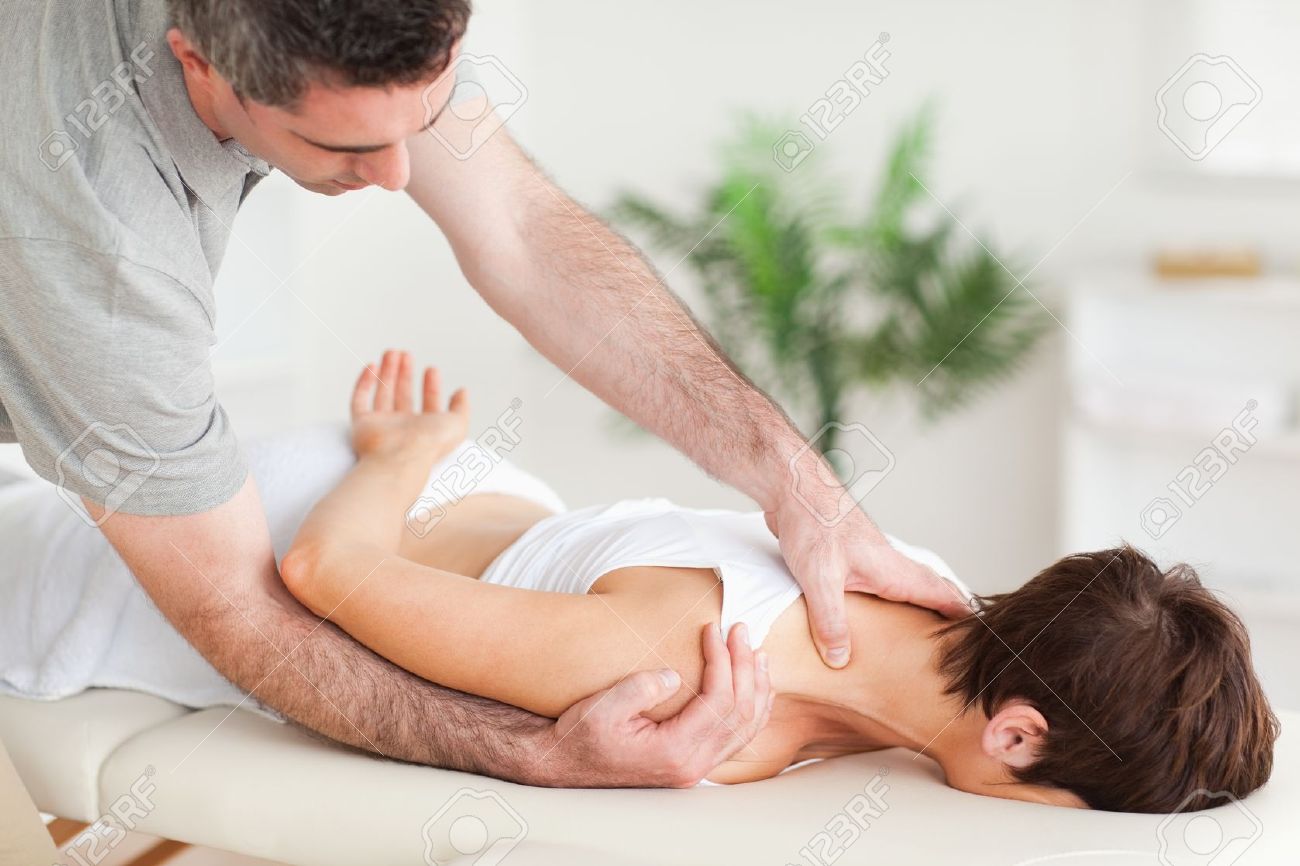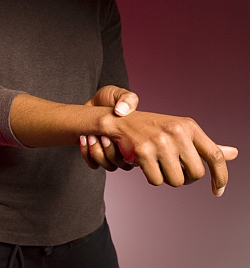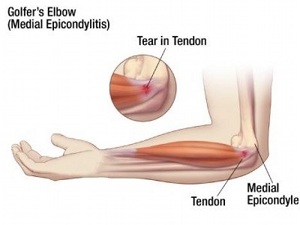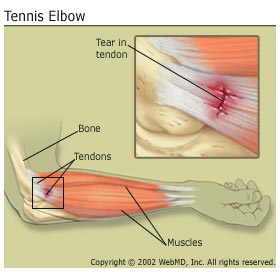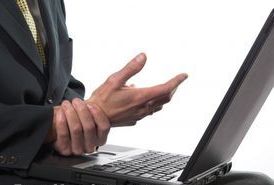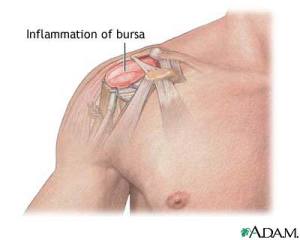Carpal Tunnel Syndrome
Carpal tunnel syndrome usually affects otherwise healthy individuals. Symptoms include numbness and tingling in the hand, accompanied by weakness in gripping. These symptoms are due to compression of the median nerve which travels from the neck, through the muscles of the forearm and wrist, to the hand. Compression may be due to inflammation of the tendons at the wrist, it can be a symptom of Rheumatoid Arthritis or other diseases, or it can result from injury or repetitive use, among other things.
Chiropractic:
Chiropractic treatment addresses all the possible causes of carpal tunnel syndrome. The key is in determining where the problem originates. If the condition arises from the wrist, chiropractic adjustments are used to restore motion to locked-up bones in the wrist, and soft tissue techniques are used on the muscles and tissues around the wrist to reduce any causes of nerve irritation. If the problem arises from the muscles irritating the nerve, then soft tissue techniques are used to break up scar tissue and relieve the nerve of excess pressure. In many cases, misalignments in the neck will cause irritation of the nerve. Chiropractic adjustments restore proper motion in the bones of the neck, thereby relieving the nerve of any compression. As the patient recovers, stretching and strengthening programs are prescribed to reduce recurrences. In some circumstances, an individual may suffer from nerve compression in both the wrist and neck; this is referred to as “double crush.” Fortunately, chiropractic addresses the origin of both problems.
Acupuncture:
Acupuncture, in conjunction with other treatments, speeds up the healing process, and decreases inflammation. Acupuncture does this by stimulating the natural release of endorphins, which are the body’s natural pain killers. Dr. Rodwin is a certified acupuncturist and will recommend this method of treatment if it is warranted.
Massage Therapy:
Massage therapy relieves pressure on the median nerve by stretching the tissue responsible for the condition. Massage will reduce scar tissue and treat any muscular compensation that may be taking place. The wrist bones may be loosened through “joint play” techniques, and any swelling can be decreased with lymphatic drainage.
Golfer’s Elbow or Medial Epicondylitis
Golfer’s elbow is inflammation of the tendon that attaches to the inside of the elbow. These tendons are responsible for bending the wrist forward.
Chiropractic:
Chiropractic adjustments restore motion to the elbow joint and increase the range of motion. Ice and interferential current may be used to reduce the amount of inflammation in the area. ART is used to break up scar tissue and improve joint function. Stretching and strengthening exercises are incorporated into the treatment plan at the appropriate time to reduce the possibility of re-injury.
Acupuncture:
Acupuncture, in conjunction with other treatments, speeds up the healing process, and decreases inflammation. Acupuncture does this by stimulating the natural release of endorphins, which are the body’s natural pain killers. Dr. Rodwin is a certified acupuncturist and will recommend this method of treatment if it is warranted.
Massage Therapy:
The first step of massage therapy is to decrease inflammation. The second most important consideration is to reduce irritating adhesions, then increase circulation to compromised tissue, and then to maintain range of motion of the affected joint. Restoration of muscle strength and length are additional goals of massage therapy.
Rotator Cuff Injuries
The rotator cuff involves four muscles that surround and support the shoulder joint. Sometimes these muscles get strained and irritated. Varying conditions often result in painful restriction of the range of motion of the shoulder joint.
Chiropractic:
Chiropractic treatment involves addressing any shoulder joint restrictions with chiropractic adjustments, and using soft tissue techniques such as ART and trigger point therapy to loosen the surrounding musculature and increase range of motion. A stretching and strengthening program is prescribed at the appropriate time to help stabilize the joint and prevent re-injury.
Acupuncture:
Acupuncture, in conjunction with other treatments, speeds up the healing process, and decreases inflammation. Acupuncture does this by stimulating the natural release of endorphins, which are the body’s natural pain killers. Dr. Rodwin is a certified acupuncturist and will recommend this method of treatment if it is warranted.
Massage Therapy:
The aim of massage therapy is to first assess the source of the joint restriction, which may include trigger points, adhesions, tendonitis or bursitis. Once this is determined, a treatment may include decreasing inflammation, reducing muscle spasms, and increasing circulation in order to maintain tissue health and range of motion. Massage also eliminates any scar tissue that restricts shoulder movement.
Tennis Elbow or Lateral Epicondylitis
Tennis elbow is inflammation of the tendon that attaches to the outside of the elbow. This tendon attaches to muscles that are responsible for bending the wrist backward.
Chiropractic:
Chiropractic adjustments restore motion to the elbow joint and increase the range of motion. Ice and interferential current may be used to reduce the amount of inflammation in the area. ART is used to break up scar tissue and improve joint function. Stretching and strengthening exercise are incorporated into the treatment plan at the appropriate time to reduce the possibility of re-injury.
Acupuncture:
Acupuncture, in conjunction with other treatments, speeds up the healing process, and decreases inflammation. Acupuncture does this by stimulating the natural release of endorphins, which are the body’s natural pain killers. Dr. Rodwin is a certified acupuncturist and will recommend this method of treatment if it is warranted.
Massage Therapy:
Massage therapy decreases inflammation, reduces irritating adhesions, increases circulation to compromised tissue, and maintains range of motion of the affected joint. Restoration of muscle strength and length are additional goals of massage therapy. Massage therapy also helps to prevent recurrence by addressing perpetuating factors or causes.
Repetitive Strain Injuries (RSIs)
Repetitive Strain Injuries (RSIs) caused by cumulative trauma are now the major cause of injuries in the workforce.
Statistics show that the number of patients suffering from cumulative trauma has now surpassed those suffering from back pain. RSI cases have increased at a phenomenal rate of 670 % over the last five years.
Common therapies such as cross friction massage, heat, cold, electrical stimulation, rest, exercise, and surgery – have all failed to treat cumulative trauma effectively.
It is not always easy to see all of the factors of a RSI. That is one reason to seek professional help from someone trained to work with the structures affected by RSIs. Chiropractic is a good choice. A chiropractor’s training has an emphasis on the muscles, bones, joints, nerves, and connective tissue of your body.
Chiropractic and Active Release Technique (ART):
Chiropractic treatment addresses all the possible causes of the RSI. The key is in determining where the problem originates. For example, if the condition arises from the wrist, chiropractic adjustments are used to restore motion to locked-up bones in the wrist. If the problem arises from the muscles irritating the nerve, ART is used to break up scar tissue and relieve the nerve of excess pressure. Depending on the RSI, misalignments in the spine can cause irritation of the nerve. Chiropractic adjustments restore proper motion in the joints of the spine, thereby relieving the nerve of any compression. As the patient recovers, stretching and strengthening programs are prescribed to reduce recurrences. In some circumstances, an individual may suffer from nerve compression in both the wrist and neck; this is referred to as “double crush.” Fortunately, chiropractic addresses the origin of both problems.
Acupuncture:
Acupuncture, in conjunction with other treatments, speeds up the healing process, and decreases inflammation. Acupuncture does this by stimulating the natural release of endorphins, which are the body’s natural pain killers. Dr. Rodwin is a certified acupuncturist and will recommend this method of treatment if it is warranted.
Massage Therapy:
Massage therapy relieves pressure on the nerves by stretching the tissue responsible for the condition. Massage/ART will reduce scar tissue and treat any muscular compensation that may be taking place.
Bursitis
Bursitis is the inflammation of one or more bursae (small sacs) of synovial fluid in the body. The bursae rest at the points where internal functionaries, such as muscles and tendons, slide across bone. Healthy bursae create a smooth, almost frictionless functional gliding surface, making normal movement painless. When bursitis occurs, however, movement relying upon the inflamed bursa becomes difficult and painful. Moreover, movement of tendons and muscles over the inflamed bursa aggravates its inflammation, perpetuating the problem.
Bursitis is commonly caused by repetitive movement and excessive pressure. Elbows and knees are the most commonly affected. Inflammation of the bursae might also be caused by other inflammatory conditions, such as Rheumatoid Arthritis. Scoliosis can contribute to bursitis of the shoulders; however, shoulder bursitis is more commonly caused by overuse of the shoulder joint and related muscles.
Chiropractic and Active Release Technique (ART):
Chiropractic treatment involves addressing any joint (shoulder/elbow/hip) restrictions with chiropractic adjustments, and using soft tissue techniques such as ART and trigger point therapy to loosen the surrounding musculature and increase range of motion. A stretching and strengthening program is prescribed at the appropriate time to help stabilize the joint and prevent re-injury.
Acupuncture:
Acupuncture, in conjunction with other treatments, speeds up the healing process, and decreases inflammation. Acupuncture does this by stimulating the natural release of endorphins, which are the body’s natural pain killers. Dr. Rodwin is a certified acupuncturist and will recommend this method of treatment if it is warranted.
Massage Therapy:
The aim of massage therapy is to first assess the source of the joint restriction, which may include trigger points, adhesions, tendonitis or bursitis. Once this is determined, treatment may include decreasing inflammation, reducing muscle spasms, and increasing circulation in order to maintain tissue health and range of motion. Massage also eliminates any scar tissue that restricts the joint’s movement.

